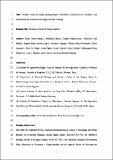Por favor, use este identificador para citar o enlazar a este item:
http://hdl.handle.net/10261/216078COMPARTIR / EXPORTAR:
 SHARE SHARE
 CORE
BASE CORE
BASE
|
|
| Visualizar otros formatos: MARC | Dublin Core | RDF | ORE | MODS | METS | DIDL | DATACITE | |

| Título: | Volatiles from the fungal phytopathogen Penicillium aurantiogriseum modulate root metabolism and architecture through proteome resetting |
Autor: | García-Gómez, Pablo CSIC ORCID; Bahaji, Abdellatif CSIC ORCID ; Gámez-Arcas, Samuel CSIC ORCID; Muñoz Pérez, Francisco José CSIC ORCID ; Sánchez-López, Ángela María CSIC ORCID ; Almagro, Goizeder CSIC ORCID ; Baroja-Fernández, Edurne CSIC ORCID CVN ; Ameztoy, Kinia CSIC ORCID CVN; Diego, Nuria de; Ugena, Lydia; Spíchal, Lukáš; Doležal, Karel; Hajirezaei, Mohammad-Reza; Romero, Luis C. CSIC ORCID ; García, Irene CSIC ORCID ; Pozueta Romero, Javier CSIC ORCID | Palabras clave: | Biostimulants Cyanide scavenging Growth promotion Hormone signaling Microbial volatile compounds Photosynthesis Plant‐microbe interaction Proteomics |
Fecha de publicación: | oct-2020 | Editor: | John Wiley & Sons | Citación: | Plant, Cell and Environment 43(10): 2551-2570 (2020) | Resumen: | Volatile compounds (VCs) emitted by the fungal phytopathogen Penicillium aurantiogriseum promote root growth and developmental changes in Arabidopsis. Here we characterized the metabolic and molecular responses of roots to fungal volatiles. Proteomic analyses revealed that these compounds reduce the levels of aquaporins, the iron carrier IRT1 and apoplastic peroxidases. Fungal VCs also increased the levels of enzymes involved in the production of mevalonate (MVA)‐derived isoprenoids, nitrogen assimilation and conversion of methionine to ethylene and cyanide. Consistently, fungal VC‐treated roots accumulated high levels of hydrogen peroxide (H2O2), MVA‐derived cytokinins, ethylene, cyanide and long‐distance nitrogen transport amino acids. qRT‐PCR analyses showed that many proteins differentially expressed by fungal VCs are encoded by VC non‐responsive genes. Expression patterns of hormone reporters and developmental characterization of mutants provided evidence for the involvement of cyanide scavenging and enhanced auxin, ethylene, cytokinin and H2O2 signaling in the root architecture changes promoted by fungal VCs. Our findings show that VCs from P. aurantiogriseum modify root metabolism and architecture, and improve nutrient and water use efficiencies through transcriptionally and non‐transcriptionally regulated proteome resetting mechanisms. Some of these mechanisms are subject to long‐distance regulation by photosynthesis and differ from those triggered by VCs emitted by beneficial microorganisms. | Versión del editor: | https://doi.org/10.1111/pce.13817 | URI: | http://hdl.handle.net/10261/216078 | DOI: | 10.1111/pce.13817 | ISSN: | 0140-7791 | E-ISSN: | 1365-3040 |
| Aparece en las colecciones: | (IDAB) Artículos |
Ficheros en este ítem:
| Fichero | Descripción | Tamaño | Formato | |
|---|---|---|---|---|
| Plant_Cell_Environ_2020.pdf | 7,06 MB | Adobe PDF |  Visualizar/Abrir |
CORE Recommender
SCOPUSTM
Citations
15
checked on 22-abr-2024
WEB OF SCIENCETM
Citations
16
checked on 25-feb-2024
Page view(s)
191
checked on 24-abr-2024
Download(s)
323
checked on 24-abr-2024
Google ScholarTM
Check
Altmetric
Altmetric
NOTA: Los ítems de Digital.CSIC están protegidos por copyright, con todos los derechos reservados, a menos que se indique lo contrario.
